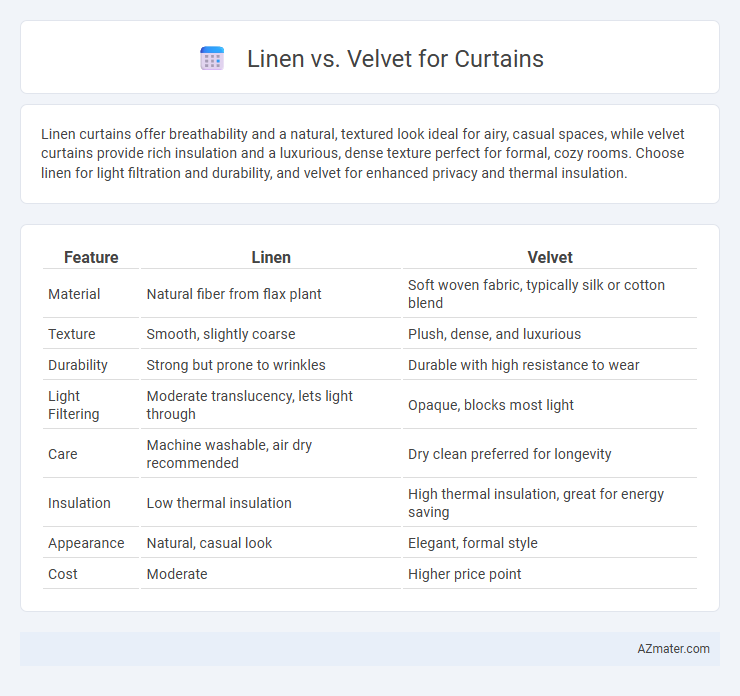Linen curtains offer breathability and a natural, textured look ideal for airy, casual spaces, while velvet curtains provide rich insulation and a luxurious, dense texture perfect for formal, cozy rooms. Choose linen for light filtration and durability, and velvet for enhanced privacy and thermal insulation.
Table of Comparison
| Feature | Linen | Velvet |
|---|---|---|
| Material | Natural fiber from flax plant | Soft woven fabric, typically silk or cotton blend |
| Texture | Smooth, slightly coarse | Plush, dense, and luxurious |
| Durability | Strong but prone to wrinkles | Durable with high resistance to wear |
| Light Filtering | Moderate translucency, lets light through | Opaque, blocks most light |
| Care | Machine washable, air dry recommended | Dry clean preferred for longevity |
| Insulation | Low thermal insulation | High thermal insulation, great for energy saving |
| Appearance | Natural, casual look | Elegant, formal style |
| Cost | Moderate | Higher price point |
Introduction to Linen and Velvet Curtains
Linen curtains, made from natural flax fibers, offer a lightweight, breathable fabric that provides a soft, elegant drape with a subtle texture ideal for creating a relaxed, airy atmosphere. Velvet curtains, crafted from woven silk, cotton, or synthetic fibers, deliver a thick, plush texture known for excellent light-blocking properties and luxurious appearance, perfect for adding warmth and sophistication to any room. Both materials vary in durability and maintenance, with linen favoring easy care and velvet requiring more delicate handling to preserve its rich pile.
Key Differences Between Linen and Velvet Fabrics
Linen curtains offer a lightweight, breathable texture ideal for airy, natural light filtering, while velvet curtains provide a heavy, plush feel that enhances insulation and sound absorption. Linen's natural fibers create a casual, textured appearance with a crisp drape, contrasting with velvet's rich, smooth finish and luxurious sheen. Durability varies as linen resists wear well under sunlight but wrinkles easily, whereas velvet maintains a soft touch but requires careful upkeep to avoid crushing and staining.
Aesthetic Appeal: Texture and Look
Linen curtains offer a natural, lightweight texture with a soft, matte finish that creates an airy and relaxed aesthetic, ideal for minimalist or coastal-inspired interiors. Velvet curtains provide a rich, plush texture with a subtle sheen that enhances luxurious and dramatic looks, perfect for traditional or opulent settings. The tactile contrast between linen's breathable fibers and velvet's dense pile significantly influences the visual depth and ambiance of any room.
Durability and Longevity Comparison
Velvet curtains offer superior durability due to their dense weave and plush fibers, making them resistant to wear and tear over time. Linen curtains, while breathable and lightweight, tend to be more prone to fraying and fading, especially when exposed to direct sunlight. Velvet's robust texture ensures a longer lifespan, making it a preferred choice for high-traffic areas requiring both elegance and endurance.
Light Control and Privacy Features
Linen curtains offer moderate light control with a natural, breathable fabric that allows soft, diffused light to filter through, ideal for creating a bright yet private ambiance. Velvet curtains provide superior light-blocking capabilities due to their dense, heavy weave, ensuring maximum privacy and effectively darkening rooms for enhanced insulation and noise reduction. Choosing between linen and velvet depends on the desired balance between natural light flow and privacy needs in interior spaces.
Maintenance and Cleaning Requirements
Linen curtains require gentle washing with mild detergent and air drying to prevent shrinkage and maintain fabric integrity, making them relatively low-maintenance. Velvet curtains demand more careful cleaning, often needing professional dry cleaning to preserve their soft texture and avoid damage from water and heat. Both fabrics benefit from regular light vacuuming to remove dust and extend their lifespan.
Thermal Insulation and Energy Efficiency
Linen curtains offer moderate thermal insulation by allowing some heat to pass through due to their lightweight, breathable fabric, making them ideal for mild climates and energy savings through natural airflow. Velvet curtains provide superior thermal insulation with their dense, plush fibers that trap heat effectively, significantly reducing heat loss and lowering energy costs in colder environments. Choosing velvet curtains enhances energy efficiency by creating a thick barrier against drafts, while linen suits warmer settings by facilitating ventilation.
Cost Comparison: Linen vs Velvet Curtains
Linen curtains generally cost less than velvet curtains due to the lower price of natural flax fibers compared to the heavy, plush materials used in velvet production. Velvet curtains tend to be more expensive because of their luxurious texture and density, which require more intricate manufacturing processes. Budget-conscious buyers often prefer linen for affordability and breathability, while velvet suits those investing in opulence and insulation despite the higher price.
Suitability for Various Interior Styles
Linen curtains offer a light, breathable texture ideal for minimalist, Scandinavian, and coastal interiors, enhancing natural light and creating an airy ambiance. Velvet curtains, with their rich texture and heavy drape, suit luxurious, traditional, and eclectic styles by adding depth and a sense of warmth to the space. Both fabrics provide unique aesthetic qualities that complement different design schemes, with linen supporting casual elegance and velvet emphasizing opulence.
Choosing the Right Fabric for Your Curtains
Linen curtains offer a lightweight, breathable option that allows natural light to filter through, ideal for bright, airy spaces, while velvet provides a heavier, luxurious fabric that blocks light and adds warmth, perfect for insulation and privacy. Consider the room's function and desired ambiance when choosing between linen and velvet; linen suits casual, relaxed environments, whereas velvet enhances formal and cozy settings. Durability and maintenance also influence the decision--linen is easier to clean and resists signs of wear, while velvet requires careful handling to preserve its texture and appearance.

Infographic: Linen vs Velvet for Curtain
 azmater.com
azmater.com